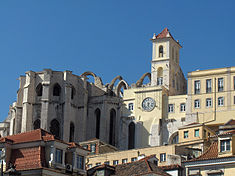Carmo Convent (Lisbon)
| Convent of Our Lady of Mount Carmel (Convento da Ordem do Carmo) | |
| Carmo Convent, National Republican Guard General Command | |
| Convent (Convento) | |
|
View on the apse of the Carmo Convent (as seen from the Rossio square)
|
|
| Official name: Convento do Carmo / Comando Geral da Guarda Nacional Republicana, GNR, do Carmo | |
| Named for: Our Lady of Mount Carmel | |
| Country | |
|---|---|
| Region | Lisbon |
| Subregion | Greater Lisbon |
| District | Lisbon |
| Municipality | Lisbon |
| Location | Santa Maria Maior |
| - coordinates | 38°42′44″N 9°8′24″W / 38.71222°N 9.14000°WCoordinates: 38°42′44″N 9°8′24″W / 38.71222°N 9.14000°W |
| Architects | Afonso Eanes, Gonçalo Eanes, Rodrigo Eanes, Leonel Gaia |
| Style | Gothic |
| Materials | Stone and mixed masonry, Painted plaster, Limestone, Marble, Terrazzo, Tile, Wood, Wrought and cast iron |
| Origin | 1389 |
| - Initiated | 1393 |
| Owner | Portuguese Republic |
| For public | Public |
| Easiest access | Largo do Carmo; Calçada do Carmo |
| Management | Instituto Gestão do Patrimonio Arquitectónico e Arqueológico |
| Status | Undefined |
| Listing | Included in the classification of the Pombaline downtown (IPA.00005966); partially included in the Protection Zone of the Água Livres Aqueduct (IPA.00006811) |
|
Location of the convent within the municipality of Lisbon
|
|
The Convent of Our Lady of Mount Carmel (Portuguese: Convento da Ordem do Carmo) is a former-Roman Catholic convent located in the civil parish of Santa Maria Maior, municipality of Lisbon, Portugal. The medieval convent was ruined during the sequence of the 1755 Lisbon earthquake, and the destroyed Gothic Church of Our Lady of Mount Carmel (Portuguese: Igreja do Carmo) on the southern facade of the convent is the main trace of the great earthquake still visible in the old city.
The convent was founded in 1389 by the Constable D. Nuno Álvares Pereira (supreme military commander of the King), from the small Carmelite convent situated on lands acquired from his sister Beatriz Pereira and the admiral Pessanha. The reconstruction of the convent began sometime in 1393.
In 1407 the presbytery and apses of the convent church was concluded, resulting in the first liturgical acts in that year. By 1423 the residential cells were completed, allowing the Carmelites from Moura (southern Portugal) to inhabit the building, including Father Nuno de Santa Maria, the Constable D. Nuno Àlvares Pereira who donated his wealth to the convent and entered the convent.
By 1551, the convent sheltered 70 clergy and 10 servants, paying land rents of approximately 2500 cruzados annually.
In 1755, an earthquake off the coast of Portugal caused significant damage to the convent and the destruction of the library, which houses approximately 5000 volumes). The 126 clerics at the time were forced to abandon the building, dislocating initially to Cotovia, then to Campo Grande.
...
Wikipedia


